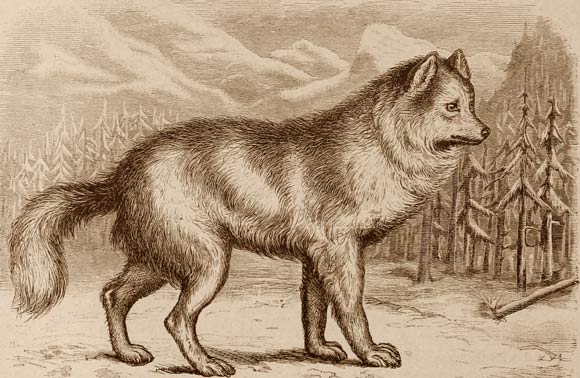An international team of scientists has isolated and sequenced RNA from the permafrost-preserved liver, cartilage and muscle tissue of a 14,300-year-old Pleistocene ‘wolf’ puppy from Tumat, Siberia.

A canid in Cassell’s Natural History. Image credit: Peter Martin Duncan / North Carolina State University / NCSU Libraries.
DNA, which encodes the hard copy of genes, is known to survive for thousands of years under favorable conditions.
But RNA — the short-lived working copy of a gene, which is transcribed from DNA in the cell and forms the instructions for making proteins — is rapidly broken down in living tissue by a suite of recycling enzymes.
That instability typically continues after death, and because of that, researchers have generally assumed that the likelihood of finding intact an ancient cell’s complement of RNA — its transcriptome — was vanishingly small.
But there have been a few exceptions, mostly in plants, which led University of Copenhagen’s Dr. Oliver Smith and his colleagues to ask whether there might be ancient animal transcriptomes well-preserved enough to be sequenced.
The team isolated and analyzed RNA from liver, cartilage and muscle tissue of a 14,300-year-old canid — possibly a wolf or partially domesticated wolf-like creature — that had been preserved in Siberian permafrost until its discovery, as well as tissue from two wolves from Greenland (19th and 20th centuries CE) for comparison.
Using a variety of transcriptomic techniques and quality control measures, the scientists showed that the RNA sequenced from liver tissue of the Tumat puppy was truly representative of the animal’s RNA, with many liver-specific transcripts that matched more modern samples from both wolves and dogs.
The canid’s transcriptome is the oldest RNA sequenced by far, surpassing the next oldest transcriptome by at least 13,000 years.
“Ancient DNA researchers have previously been reluctant to attempt to sequence ancient RNA because it is generally more unstable than DNA, and more prone to enzymatic degradation,” Dr. Smith said.
“However, following our recent successes in sequencing ancient RNA from plant material, we speculated that a well-preserved animal specimen, frozen in the permafrost, just might retain enough material to sequence.”
“To our delight, we found that not only did we find RNA from various tissues, but in some case the signal was so strong that we could distinguish between tissues in a way that makes biological sense.”
“Knowing that RNA acts as an intermediary between DNA and proteins, both of which are more stable, it might be tempting to ask, ‘so what?’ But we think the future of ancient RNA has great potential. For example, many of the most clinically relevant viruses around today have RNA genomes, and the RNA stage is often crucial to understanding the intricacies and complexities of gene regulation. This might have repercussions when discussing the environmental stresses and strains that drive evolution.”
The findings were published in the journal PLoS Biology.
_____
O. Smith et al. 2019. Ancient RNA from Late Pleistocene permafrost and historical canids shows tissue-specific transcriptome survival. PLoS Biol 17 (7): e3000166; doi: 10.1371/journal.pbio.3000166







